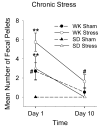Chronic psychological stress enhances nociceptive processing in the urinary bladder in high-anxiety rats
- PMID: 17521683
- PMCID: PMC2084207
- DOI: 10.1016/j.physbeh.2007.04.009
Chronic psychological stress enhances nociceptive processing in the urinary bladder in high-anxiety rats
Abstract
This study sought to determine whether acute and/or chronic psychological stress produce changes in urinary bladder nociception. Female Sprague-Dawley (SD; low/moderate anxiety) or Wistar-Kyoto (WK; high-anxiety) rats were exposed to either an acute (1 day) or a chronic (10 days) water avoidance stress paradigm or a sham stress paradigm. Paw withdrawal thresholds to mechanical and thermal stimuli and fecal pellet output, were quantified at baseline and after the final stress or sham stress exposure. Rats were then sedated, and visceromotor responses (VMRs) to urinary bladder distension (UBD) were recorded. While acute stress exposure did not significantly alter bladder nociceptive responses in either strain of rats, WK rats exposed to a chronic stress paradigm exhibited enhanced responses to UBD. These high-anxiety rats also exhibited somatic analgesia following acute, but not chronic, stress. Furthermore, WK rats had greater fecal pellet output than SD rats when stressed. Significant stress-induced changes in nociceptive responses to mechanical stimuli were observed in SD rats. That chronic psychological stress significantly enhanced bladder nociceptive responses only in high-anxiety rats provides further support for a critical role of genetics, stress and anxiety as exacerbating factors in painful urogenital disorders such as interstitial cystitis (IC).
Figures




Similar articles
-
Chronic psychological stress in high-anxiety rats induces sustained bladder hyperalgesia.Physiol Behav. 2015 Feb;139:541-8. doi: 10.1016/j.physbeh.2014.11.045. Epub 2014 Nov 20. Physiol Behav. 2015. PMID: 25449389
-
Effects of oxytocin and prolactin on stress-induced bladder hypersensitivity in female rats.J Pain. 2009 Oct;10(10):1065-72. doi: 10.1016/j.jpain.2009.04.007. J Pain. 2009. PMID: 19595642 Free PMC article.
-
The role of C-fibers in the development of chronic psychological stress induced enhanced bladder sensations and nociceptive responses: A multidisciplinary approach to the study of urologic chronic pelvic pain syndrome (MAPP) research network study.Neurourol Urodyn. 2018 Feb;37(2):673-680. doi: 10.1002/nau.23374. Epub 2017 Aug 9. Neurourol Urodyn. 2018. PMID: 28792095 Free PMC article.
-
The amygdala central nucleus is required for acute stress-induced bladder hyperalgesia in a rat visceral pain model.Brain Res. 2015 May 5;1606:77-85. doi: 10.1016/j.brainres.2015.01.008. Epub 2015 Feb 17. Brain Res. 2015. PMID: 25698616 Free PMC article.
-
Repeated exposure to water avoidance stress in rats: a new model for sustained visceral hyperalgesia.Am J Physiol Gastrointest Liver Physiol. 2005 Jul;289(1):G42-53. doi: 10.1152/ajpgi.00500.2004. Epub 2005 Mar 3. Am J Physiol Gastrointest Liver Physiol. 2005. PMID: 15746211
Cited by
-
Effects of pregabalin on neurobehavior in an adult male rat model of PTSD.PLoS One. 2018 Dec 31;13(12):e0209494. doi: 10.1371/journal.pone.0209494. eCollection 2018. PLoS One. 2018. PMID: 30596711 Free PMC article.
-
Stress-induced autonomic dysregulation of mitochondrial function in the rat urothelium.Neurourol Urodyn. 2019 Feb;38(2):572-581. doi: 10.1002/nau.23876. Epub 2018 Dec 21. Neurourol Urodyn. 2019. PMID: 30575113 Free PMC article.
-
Repeated variate stress in male rats induces increased voiding frequency, somatic sensitivity, and urinary bladder nerve growth factor expression.Am J Physiol Regul Integr Comp Physiol. 2013 Jul 15;305(2):R147-56. doi: 10.1152/ajpregu.00089.2013. Epub 2013 May 8. Am J Physiol Regul Integr Comp Physiol. 2013. PMID: 23657640 Free PMC article.
-
NAD(P)H:quinone oxidoreductase 1 protects bladder epithelium against painful bladder syndrome in mice.Free Radic Biol Med. 2012 Nov 15;53(10):1886-93. doi: 10.1016/j.freeradbiomed.2012.08.584. Epub 2012 Aug 31. Free Radic Biol Med. 2012. PMID: 22985937 Free PMC article.
-
Vaginal hypersensitivity and hypothalamic-pituitary-adrenal axis dysfunction as a result of neonatal maternal separation in female mice.Neuroscience. 2014 Mar 28;263:216-30. doi: 10.1016/j.neuroscience.2014.01.022. Epub 2014 Jan 23. Neuroscience. 2014. PMID: 24462609 Free PMC article.
References
-
- Merskey H. The need of a taxonomy: Pain terms: A list of definitions and notes on usage. Pain. 1979;6:247–252. - PubMed
-
- Merskey H, Bogduk N. IASP Task Force on Taxonomy. IASP Press; Seattle: 1994. pp. 209–214.

